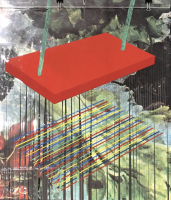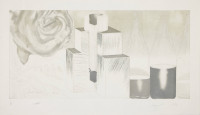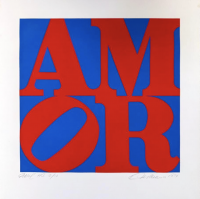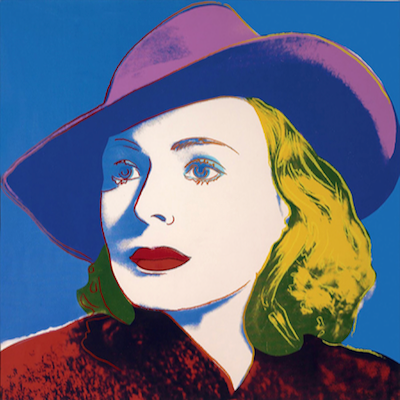


Details
Artist
Styles
Color screen-print on paper // Tom Wesselmann’s Monica Sitting with Mondrian (1989) is a vibrant screenprint that merges the iconic geometric abstraction of Piet Mondrian with Wesselmann's bold Pop Art style. This limited edition print features a stylized nude figure, Monica, outlined in soft, curving lines, contrasting sharply with Mondrian's rigid grid of primary colors in the background. The minimalist depiction of Monica, accented by her dark bob hairstyle and subtle use of color, exemplifies Wesselmann's fascination with form, femininity, and the interplay between different artistic movements. By positioning a modern female figure against the backdrop of Mondrian's abstract compositions, Wesselmann bridges the gap between figurative and abstract art, creating a thought-provoking dialogue on modernism and the human form. Signed and numbered by the artist, this piece reflects his enduring impact on Pop Art and contemporary aesthetics.
Somewhere to Light, 1966
form
Medium
Size
43.2 x 55.9 cm
- Inches
- Centimeters
Edition
Price
- USD
- EUR
- GBP
Details
Artist
Styles
Color screen-print on paper // Tom Wesselmann’s Monica Sitting with Mondrian (1989) is a vibrant screenprint that merges the iconic geometric abstraction of Piet Mondrian with Wesselmann's bold Pop Art style. This limited edition print features a stylized nude figure, Monica, outlined in soft, curving lines, contrasting sharply with Mondrian's rigid grid of primary colors in the background. The minimalist depiction of Monica, accented by her dark bob hairstyle and subtle use of color, exemplifies Wesselmann's fascination with form, femininity, and the interplay between different artistic movements. By positioning a modern female figure against the backdrop of Mondrian's abstract compositions, Wesselmann bridges the gap between figurative and abstract art, creating a thought-provoking dialogue on modernism and the human form. Signed and numbered by the artist, this piece reflects his enduring impact on Pop Art and contemporary aesthetics.
- Recently Added
- Price (low-high )
- Price (high-low )
- Year (low-high )
- Year (high-low )
James Rosenquist
Whipped Butter For Eugene, 1965
Limited Edition Print
Screen-print
Inquire For Price
James Rosenquist
Where The Water Goes (from The Welcome To The Water Planet), 1989
Limited Edition Print
Collage
Inquire For Price
James Rosenquist
Federal Spending (second State), 1978
Limited Edition Print
Etching And Aquatint
Inquire For Price
James Rosenquist
A Pale Angels Halo (Yellow), 1973
Limited Edition Print
Lithograph
Inquire For Price
James Rosenquist
Federal Spending, 1978
Limited Edition Print
Etching And Aquatint
Inquire For Price
James Rosenquist
Just Desert Israel 2nd State, 1979
Limited Edition Print
Intaglio
Inquire For Price
James Rosenquist
Window Washer Glass House (black And White), 1978
Limited Edition Print
Mixed Media
Inquire For Price
James Rosenquist
The Flame Still Dances On Leos Book, 1997
Limited Edition Print
Lithograph
Inquire For Price
James Rosenquist
The Kabuki Blushes (from Secrets In Carnations), 1986
Limited Edition Print
Mixed Media
USD 8,950
James Rosenquist
The Book Disappears For The Fast Student 2nd State, 1978
Limited Edition Print
Etching And Aquatint
USD 1,100
James Rosenquist
Spring Cheer, 1st. State , 1978
Limited Edition Print
Etching And Aquatint
USD 4,250
James Rosenquist
Sunglass Lens - Landing Net - Triangle, 1974
Limited Edition Print
Etching
Inquire For Price
James Rosenquist
The World Art Festival, 1982
Limited Edition Print
Lithograph
Currently Not Available
What is pop-art?
Pop Art is an art movement that began in Britain in 1955 and in the late 1950s in the U.S. It challenged traditional fine arts by incorporating imagery from popular culture, such as news, advertising, and comic books. Pop Art often isolates and recontextualizes materials, combining them with unrelated elements. The movement is more about the attitudes and ideas that inspired it than the specific art itself. Pop Art is seen as a reaction against the dominant ideas of Abstract Expressionism, bringing everyday consumer culture into the realm of fine art.



























































